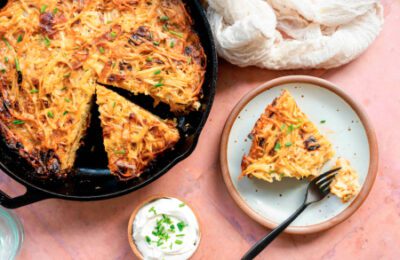One of our favorite Rosh Hashana traditions is the seder of symbolic foods. We all know about apples & honey (and the stickiness that follows!), but there are a host of other fruit and veg that carry symbolic meaning. In some circles, particularly within Sephardic and chasidic families, the highlight of Rosh Hashana dinner is the ritual of eating foods that represent our wishes for the upcoming year.
We’ve blogged about the tradition in the past, and even given you some recipe ideas, but this year we’ve gone one step further and put together the seder itself. Granted, we left off the fish head and a few other items (like black-eyed peas, which we had a difficult time sourcing), but we did incorporate several of the key ingredients: Carrots, fenugreek, beetroot, pomegranate, gourd (we used pumpkin) and leeks. For the meanings behind this choice of produces, read our earlier blog entry, “Rosh Hashana seder“).
The brilliant thing about this seder is that it handily serves as a first course, together with your round challahs of course!

For our Carrot Salad, we used one of our favorite recipes, via Smitten Kitchen, which blends a variety of spices with lemon juice, Tunisian harissa paste and fresh herbs. Our only adjustment was to add half a teaspoon of toasted fenugreek seed. (If you’re serving a meat meal, simply leave off the feta.)
Like the carrot salad, which incorporates two of the symbols, carrots and fenugreek, our Beet Salad studded with ruby-red pomegranate seeds is also a ‘two-fer’. The recipe is simple, but it’s all about the taste buds, so make sure to taste before serving, adjusting for seasoning.
2-4 roasted or boiled beets, diced
the seeds of half a pomegranate
one small red onion, thinly sliced into half moons
cilantro & fresh mint to taste
Dress with the juice of half a lime (more to taste), 1 teaspoon of salt, 1/4 t pepper, 1/4 t ground cumin, 4 T olive oil.
The Leek Salad was a spontaneous creation. We thinly sliced and caramelized four leeks (white part only). Once cooled, we tossed the leeks with a dressing made of 1 T balsamic vinegar, 4 T olive oil, 1 1/2 t mustard, 1 t salt, 1/2 t freshly ground black pepper. We also added 2 T of fresh dill.
The recipe we had most fun cooking was the Pumpkin Dip, or Kara’a. Not only was it simple to make (if you buy squash already diced) and tasted fantastic, but its name reflected the reason why it’s part of the Rosh Hashana seder. Like most of the symbols, gourd is included because of its name. In Aramaic, kraa, means to proclaim and we pray that our merits will be proclaimed before G-d. The recipe we cooked, a Libyan pumpkin dip, is called Kara’a. We got a kick out of that! The recipe we used came via Jewish Women International.
We hope we’ve inspired you to try out a Rosh Hashana seder this year! Let us know which fruit and veg you decided to include.
Happy New Year!













